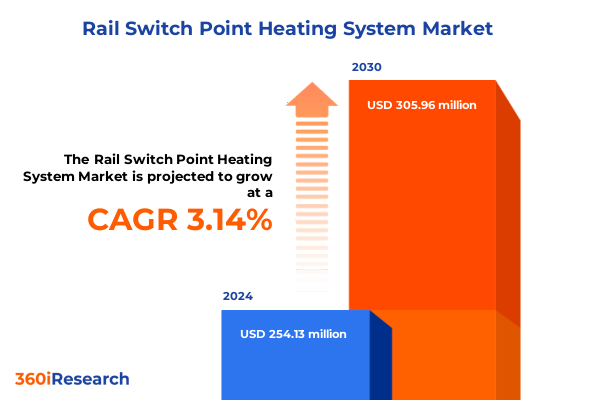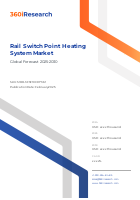The Rail Switch Point Heating System Market size was estimated at USD 254.13 million in 2024 and expected to reach USD 261.71 million in 2025, at a CAGR 3.14% to reach USD 305.96 million by 2030.

Introduction to Rail Switch Point Heating Systems Landscape
The rail switch point heating system market is at a pivotal juncture as global rail networks expand and modernization initiatives accelerate. Rail operators face the dual challenge of ensuring uninterrupted service during harsh weather while meeting stringent safety and environmental standards. Advanced systems now integrate intelligent controls, sensors and robust heating elements to prevent ice buildup at critical switch points, reducing delays and maintenance costs. As electrification and digitalization efforts intensify, stakeholders are prioritizing solutions that deliver energy efficiency, remote monitoring and seamless compatibility with existing infrastructure. Against this backdrop, understanding the evolving technology landscape, regulatory drivers and adoption barriers has never been more crucial. This executive summary presents a concise yet in-depth overview of market dynamics, tariff impacts and strategic insights to guide decision-makers in optimizing their switch point heating investments.
Transformative Shifts Reshaping the Market Dynamics
Rail switch point heating has evolved from simple electric coils to sophisticated, networked solutions that harness real-time data and predictive algorithms. Digital transformation has introduced smart controllers capable of learning local climate patterns, adjusting power output dynamically and alerting maintenance teams before performance degrades. Meanwhile, the shift toward low-carbon energy sources has spurred development of hybrid systems combining electric, gas and hydronic technologies to balance reliability with emissions goals.
Environmental regulations in key regions now mandate minimum uptime for rail services, driving investment in redundant heating elements and automated diagnostics. At the same time, rail operators are forging partnerships with IoT specialists to integrate switch point monitoring into broader asset management platforms. These transformative shifts are not merely technical upgrades-they redefine service levels and cost structures, compelling suppliers and operators alike to adapt their strategies.
Cumulative Impact of 2025 United States Tariffs
The implementation of cumulative tariffs on imported heating system components in 2025 has introduced both complexity and opportunity. Higher duties on controllers and specialized sensors imported into the United States have prompted manufacturers to reassess their global production footprints. Some suppliers have turned to nearshoring or partnered with North American fabricators to mitigate additional costs, fostering new collaborations and regional supply chains.
In turn, these shifts have led to localized innovation, with several domestic players investing in R&D to produce sensors and controllers that meet stringent performance standards while complying with tariff regulations. Although end users have experienced temporary price adjustments, operators are benefiting from enhanced lead-time reliability and diversified sourcing options. Looking ahead, the industry must balance cost pressures with the imperative to uphold system performance and regulatory compliance.
Key Segmentation Insights Driving Market Developments
A granular segmentation analysis reveals distinct growth trajectories and technology requirements across components, system types and applications. When examining the market across controllers, heating elements, sensors and switch point monitors, controllers emerge as critical enablers of automated temperature regulation, while sensors drive predictive maintenance capabilities. Heating elements remain the workhorses that deliver rapid, uniform thermal output, supported by monitors that confirm switch point readiness.
In parallel, electric heating systems, gas heating systems and hydronic heating systems each cater to different operational priorities: electric solutions excel in regions with clean grid mixes, gas systems offer autonomy in remote corridors, and hydronic technologies deliver high thermal inertia suited to extreme climates. Application contexts further diversify demand: light rail and tram networks prioritize compact, low-voltage assemblies; mainline railways demand high-capacity, heavy-duty modules; subways require corrosion-resistant designs and integration with underground power infrastructures. Together, these segmentation layers shape procurement strategies and innovation roadmaps for suppliers and operators alike.
This comprehensive research report categorizes the Rail Switch Point Heating System market into clearly defined segments, providing a detailed analysis of emerging trends and precise revenue forecasts to support strategic decision-making.
- Component
- Type
- Application
Key Regional Insights and Market Variations
Regional dynamics exert a profound influence on rail switch point heating adoption and technology preferences. In the Americas, robust investment in commuter and freight rail corridors has accelerated penetration of smart controllers and modular heating elements, with a strong emphasis on remote diagnostics and energy efficiency. Major North American operators are standardizing on systems compatible with existing positive train control frameworks, bolstering network resilience.
Across Europe, Middle East and Africa, diverse climates and aging rail infrastructures have spurred tailored solutions: Scandinavian networks deploy high-capacity hydronic heaters to counter arctic conditions, while Central European operators lean toward hybrid gas-electric systems to balance installation costs with performance. In the Middle East, rapid metro expansions prioritize lightweight electric systems with minimal footprint, as urban planners seek to minimize civil engineering demands.
In Asia-Pacific, the proliferation of high-speed rail corridors and urban metros in China, Japan, India and Australia has generated demand for scalable, low-maintenance technologies. Suppliers are collaborating with regional integrators to optimize switch point heating packages for high-frequency operations, emphasizing digital monitoring to meet tight safety and reliability standards.
This comprehensive research report examines key regions that drive the evolution of the Rail Switch Point Heating System market, offering deep insights into regional trends, growth factors, and industry developments that are influencing market performance.
- Americas
- Asia-Pacific
- Europe, Middle East & Africa
Key Companies Insights and Competitive Positioning
Competition in rail switch point heating is intensifying as established players and regional specialists vie for strategic contracts. Caloplex Ltd has distinguished itself through modular electric heating assemblies designed for rapid retrofit projects, while Conflux AB leverages advanced fin-type heaters to deliver uniform thermal distribution under extreme conditions. Eliko Holding AG and Eltherm GmbH collaborate on turnkey heating trace systems that integrate seamlessly with signaling networks, emphasizing energy management features.
FILKAB AD and Furrer + Frey AG have gained traction in harsh-environment markets by offering hydronic and gas-fired solutions certified for subzero operations. Mitsubishi Electric Corporation and NIBE Industrier AB. leverage their global manufacturing scale to supply controllers and heating elements with advanced IoT connectivity. nVent Electric plc and Omega Heat Tracing LLC focus on standardization and interoperability, ensuring compatibility with major rail infrastructure management platforms.
Further down the value chain, PINTSCH GmbH specializes in corrosion-resistant switch point monitors, while SCHUNK Kohlenstofftechnik GmbH delivers carbon-based heating elements optimized for rapid response times. ThermOmegaTech, Inc. and Thermon Group Holdings, Inc. address niche applications with custom valves and trace systems, and Yeltech Ltd offers predictive analytics software to enhance preventive maintenance regimes. On the operator side, ÖBB-Infrastruktur AG pioneers large-scale deployments in alpine conditions, setting benchmarks for resilience and service continuity.
This comprehensive research report delivers an in-depth overview of the principal market players in the Rail Switch Point Heating System market, evaluating their market share, strategic initiatives, and competitive positioning to illuminate the factors shaping the competitive landscape.
- Caloplex Ltd
- Conflux AB
- Eliko Holding AG
- Eltherm GmbH
- FILKAB AD
- Furrer + Frey AG
- Mitsubishi Electric Corporation
- NIBE Industrier AB.
- nVent Electric plc
- Omega Heat Tracing LLC
- PINTSCH GmbH
- SCHUNK Kohlenstofftechnik GmbH
- ThermOmegaTech, Inc.
- Thermon Group Holdings, Inc.
- Yeltech Ltd
- ÖBB-Infrastruktur AG
Actionable Recommendations for Industry Leaders
To thrive in an increasingly complex environment, industry leaders should prioritize five strategic imperatives. First, invest in IoT-enabled controls and predictive analytics platforms to drive condition-based maintenance and minimize unplanned downtime. Second, diversify supply chains by forging partnerships with regional fabricators and service providers to mitigate tariff exposure and logistics risks.
Third, develop modular, scalable heating solutions that can be tailored across controllers, heating elements, sensors and monitors to address the distinct operational demands of light rail, mainline and subway applications. Fourth, collaborate with standards bodies and rail authorities to shape interoperability guidelines, ensuring seamless integration with signaling and asset management systems. Fifth, cultivate talent through specialized training programs, empowering maintenance teams to leverage smart diagnostics and reduce mean time to repair. By aligning technology roadmaps with operator needs and regulatory landscapes, suppliers can convert market complexity into competitive advantage.
Explore AI-driven insights for the Rail Switch Point Heating System market with ResearchAI on our online platform, providing deeper, data-backed market analysis.
Ask ResearchAI anything
World's First Innovative Al for Market Research
Conclusion: Navigating Opportunities and Challenges
As rail networks continue to evolve, switch point heating systems will remain a critical component of safe, reliable operations. Technological innovation-driven by digital controls, hybrid energy sources and predictive maintenance-will unlock higher service levels and lower life cycle costs. Regional dynamics, regulatory strains and tariff pressures will reshape supply chains and spur new forms of collaboration between manufacturers and operators.
By understanding the nuanced demands across component, type and application segments, and by adapting to regional climate and infrastructure conditions, stakeholders can position themselves at the forefront of this specialized market. Robust competitive analyses and strategic alliances will be essential for capturing growth opportunities and mitigating risks associated with trade policies and energy transitions.
This section provides a structured overview of the report, outlining key chapters and topics covered for easy reference in our Rail Switch Point Heating System market comprehensive research report.
- Preface
- Research Methodology
- Executive Summary
- Market Overview
- Market Dynamics
- Market Insights
- Cumulative Impact of United States Tariffs 2025
- Rail Switch Point Heating System Market, by Component
- Rail Switch Point Heating System Market, by Type
- Rail Switch Point Heating System Market, by Application
- Americas Rail Switch Point Heating System Market
- Asia-Pacific Rail Switch Point Heating System Market
- Europe, Middle East & Africa Rail Switch Point Heating System Market
- Competitive Landscape
- ResearchAI
- ResearchStatistics
- ResearchContacts
- ResearchArticles
- Appendix
- List of Figures [Total: 22]
- List of Tables [Total: 147 ]
Contact Ketan Rohom to Access the Full Market Research Report
For a comprehensive, data-driven understanding of rail switch point heating system trends, technology benchmarks and competitive landscapes, engage directly with Ketan Rohom, Associate Director, Sales & Marketing. Secure your access to the full market research report and equip your organization with the insights needed to drive strategic decisions and operational excellence.

- How big is the Rail Switch Point Heating System Market?
- What is the Rail Switch Point Heating System Market growth?
- When do I get the report?
- In what format does this report get delivered to me?
- How long has 360iResearch been around?
- What if I have a question about your reports?
- Can I share this report with my team?
- Can I use your research in my presentation?




